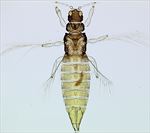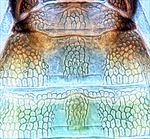
Female - teneral

Female - mature

Head & thorax

Antenna

haemorrhoidalis tergites I-II

haemorrhoidalis tergites VI-X

haemorrhoidalis fore wing
Generic diagnosis
Female macropterous. Head wider than long, strongly reticulate, not projecting in front of eyes; ocellar region weakly elevated, occipital ridge absent, cheeks constricted at base; two pairs of postocular setae; maxillary palps 2-segmented. Antennae 8-segmented, segment I without paired dorso-apical setae; III with one simple sense cone, IV with two simple sense cones. Pronotum strongly reticulate, no long setae. Mesonotum entire, reticulate, anteromedian campaniform sensilla absent. Metanotum strongly reticulate with triangle, median setae behind anterior margin, campaniform sensilla present. Fore wing costal setae shorter than anterior fringe cilia; first vein with wide gap in setal rows, three distal setae; second vein setae widely spaced; clavus with three veinal but no discal setae; posteromarginal fringe cilia wavy. Prosternal ferna widely divided; basantra membranous and without setae; mesosternal endofurca without spinula, metasternal endofurca transverse without spinula. Legs strongly reticulate, tarsi 1-segmented. Tergites without ctenidia, with entire craspedum; tergite II without special sculpture; II–VIII reticulate except for paired posterior submedian smooth areas; VIII with complete comb; IX with anterior pair of campaniform sensilla; X median split complete. Sternites entirely reticulate, craspedum entire; II–VII with three pairs of posteromarginal setae; VII with two small additional setae.
Male sternites III–VII each with a pore plate.
Biological data
Found on many different plant species, but usually breeding only on older leaves.
Distribution data
The four species of Heliothrips are all originally from South America, but haemorrhoidalis, the Greenhouse Thrips, is found all over the world, and although longisensibilis was described from China it is considered to be introduced from Brazil (Xie et al., 2019).
Nomenclatural data
Heliothrips Haliday, 1836: 443. Type species Heliothrips adonidum Haliday 1836, synonym of Thrips haemorrhoidalis Bouché, by monotypy.
This genus includes four recognised species (Nakahara et al., 2015), and two of these are known from China:
haemorrhoidalis (Bouche, 1833: 42). (Thrips)
longisensibilis Xie, Mound & Zhang, 2019: 145.
Relationship data
Thripidae sub-family Panchaetothripinae: this group is represented widely around the world, particularly in tropical areas, and comprises about 40 genera. The Neotropical genus Heliothrips seems to be related to a group of Old World genera that includes Phibalothrips and Rhipiphorothrips (Mound et al., 2001). The species included in these genera all have the fore wing veinal setae very small.
References
Mound LA, Marullo R & Trueman JWH (2001) The greenhouse thrips, Heliothrips haemorrhoidalis, and its generic relationships within the sub-family Panchaetothripinae (Thysanoptera; Thripidae). Journal of Insect Systematics and Evolution 32: 1–12.
Nakahara S, O’Donnell CA & Mound LA (2015) Heliothrips haemorrhoidalis and its relatives, with one new species and one new genus (Thysanoptera). Zootaxa 4021 (4): 578–584.
ThripsWiki (2020) ThripsWiki - providing information on the World's thrips. <http://thrips.info/wiki/Main_Page>
Xie Y, Mound LA & Zhang H (2019) A new species of Heliothrips (Thysanoptera, Panchaetothripinae), based on morphological and molecular data. Zootaxa 4638 (1): 143–150.